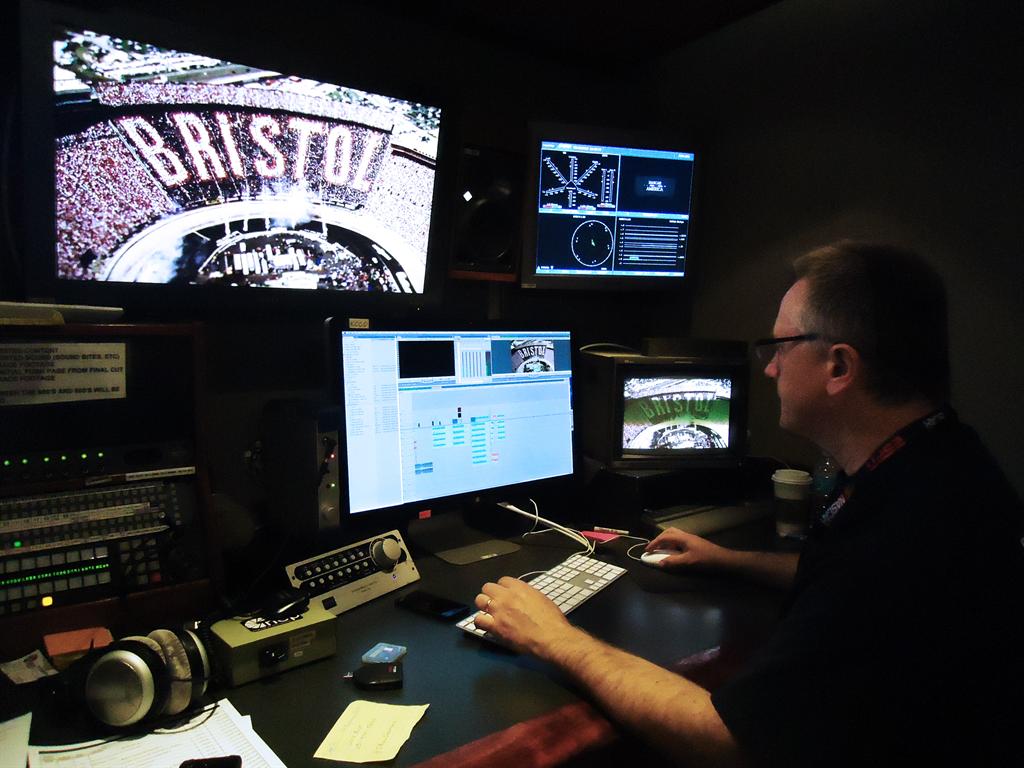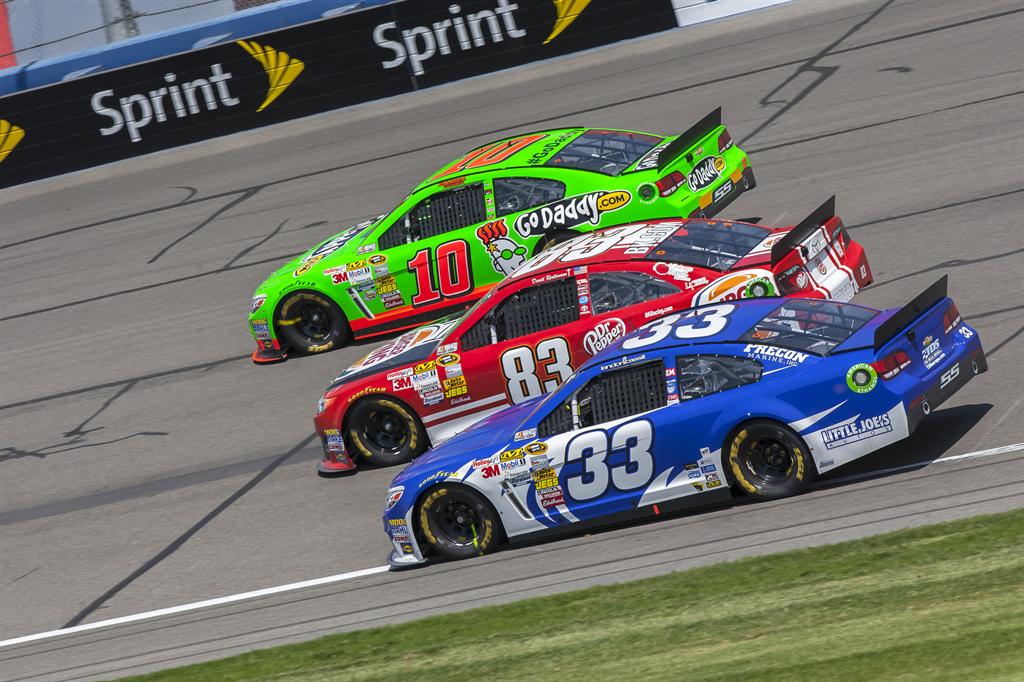For ESPN, Editing NASCAR a Torrid Event

ESPN NASCAR Editor Michael Gay works out of an edit room in an NEP OB truck at a racetrack.
BRISTOL, CONN.—For a sport as popular and as lighting fast as NASCAR, it stands to reason that there are plenty of fast machines and fast editors involved when covering a race where the cars zoom around the track at around 200 miles per hour.
Sometimes, the broadcast crew must feel like they’re doing their jobs at a similar speed.
For networks like ESPN, there are varying angles to editing NASCAR races; some cuts originate from the track, others from the edit room at the studio for other programming, as they do each weekend at the network’s Bristol, Conn., studios.
That’s where ESPN operates from 10 Avid suites in the postproduction area, with many more Quantel edit rooms on the studio side, said Kate Jackson, coordinating producer, motorsports for ESPN. Its editors are “in-house and they’re used to working on all of the different shows here, so there is a heavy scheduling angle” to coordinating the editing for any one sport.
FROM THE TRACK
That scheduling angle gets heavy enough that, for its NASCAR and IndyCar broadcasts, ESPN also works with Bluefoot Entertainment, a post house in West Hartford, Conn., on specialized projects for the broadcasts.
Jackson said that the network really doesn’t feed much content back outside of the actual telecast. Later, “The broadcast gets sent back to Bristol for archival purposes for promos, vignettes and teases, so when we get [to the tracks] they’re edited into the broadcasts,” she said. “But for the road, we have a traveling editing unit with Final Cut Pro, with a secondary Final Cut Pro on hand as a digitized ingest machine,” Jackson said, as well as an EVS system; from there, the content moves to an X file. The network keeps one on the road and one at home, so all hands have access.
ESPN also employs two ENG shooters for the broadcast (with two more working for its news and information division) at the track to shoot B-roll or specialty segments, gather qualifying information and conduct interviews. All told, the network employs about 65 cameras each weekend, first for the Nationwide races the network airs during the first part of the year; then in July, when its Sprint Cup coverage begins.
“Our setup is exactly the same every weekend,” Jackson said. “The only thing that’s different might be the setups of the cameras, since the tracks are all different.”
BACK AT BRISTOL
“Different” is a word that Greg Borbas might use to describe working on the NASCAR broadcasts—“different,” as in unique, “since they were among our first productions that went to ENG on site, which created a challenge for the NASCAR crew working with headquarters,” said Borbas, manager of creative services/postproduction for ESPN in Bristol.
When NASCAR footage is sent to Bristol, “it must be distributed to many entities in the company,” said Borbas. “First, the content is converted to Quantel media, then it’s distributed throughout the plant for ‘Sports Center’ and all the other shows, including ‘NASCAR Now,’ plus the regular features and interviews that air across ESPN’s platforms.
All told, Borbas said that ESPN’s editors in Bristol service NASCAR broadcasts and its interstitial programming between 30 and 60 hours each week. “So technically, when producers come to work with us, they have screened their media on Quantel systems. It’s brought to our Avid in clips that are ingested, in real-time, into the Avid environment.
All of the Avid systems are connected to an Avid Isis 7000, which is also connected to the EVS network and the Quantel network to expedite delivery to various producers. Also, all of the post edit rooms used for NASCAR have After Effects.
“The producers also have other media that they bring in on tape, on DVCPRO, for instance,” he said. “That’s how we get the source material in here. It may not be the most graceful delivery method,” he said, “but it works and we’re honing it daily.”
ESPN contracts with NEP Supershooters (among other mobile companies) each weekend, with NEP setting up five trucks: four in the television compound, with one in the infield, plus support vehicles.

“There are basically two edit rooms set up within two of the trucks. They each contain two full Final Cut Pro editing systems, with one of the two also containing a third Final Cut Pro setup that’s used for ingest,” said Jason Honkus, NEP’s engineering manager. “That’s where the tape and editing archives are stored.”
The ingest system is tied into the overall EVS network, which is in a third mobile unit, which Honkus calls the “B” unit. The other trucks are for production and studio setup.
All of the edit machines are Final Cut Pro Mac towers and all share content via fiber controlled by a SAN, with MetaSAN software from Tiger Technology. “They’re heavily involved in building rollout packages, said Honkus, “and getting everything ready for the main playback machines.”
The end result? A final 10–15 minute highlight cut is generally sent back to Bristol for the early “SportsCenter” show (and ESPN’s other programming) via satellite from ESPN’s preferred provider (Mobile Satellite Connection, Mobile, Ala.), according to Honkus. Any other content is carried back to Bristol on hard drives.
With all of that content, bandwidth always seems to be an issue, “because there are so many people pushing info back and forth, starting with the cameras, giving content to the editors and preparing it to send back,” Honkus said.
Another issue concerns the high amount of content shot on ENG that comes back “on a little hard drive card,” he said. “So we made a custom P2 reader that basically drops that content right into the edit flow.”
‘NEVER FINISHED’
Jackson has worked on many sports at ESPN and offered that working on NASCAR is like setting up for the Super Bowl every weekend, “except we do it 35 weeks a year, with many more cameras,” she said. For the sake of comparison, 19 cameras are used on a typical college football telecast, with the count in the mid-30s for “Monday Night Football.”
As for cutting NASCAR broadcasts, she said that edits are never finished, merely abandoned. “There’s always more you can do,” Jackson said. “There is so much coming in and you want to turn it around and send it back out— while making sure that you have all of the pieces needed for the edit.”
The professional video industry's #1 source for news, trends and product and tech information. Sign up below.
Mark R. Smith has covered the media industry for a variety of industry publications, with his articles for TV Technology often focusing on sports. He’s written numerous stories about all of the major U.S. sports leagues.
Based in the Baltimore-Washington area, the byline of Smith, who has also served as the long-time editor-in-chief for The Business Monthly, Columbia, Md., initially appeared in TV Technology and in another Futurenet publication, Mix, in the late ’90s. His work has also appeared in numerous other publications.

